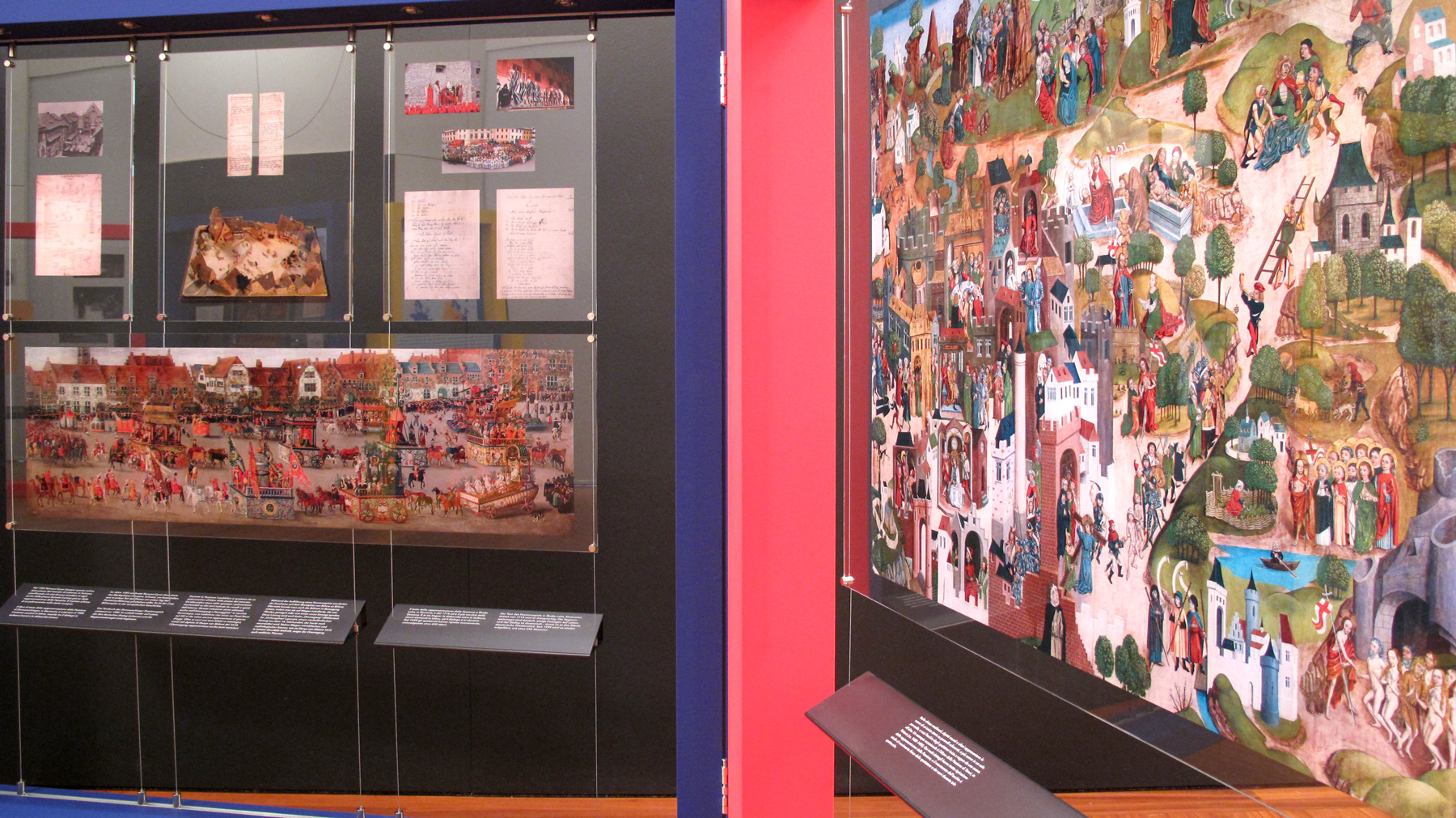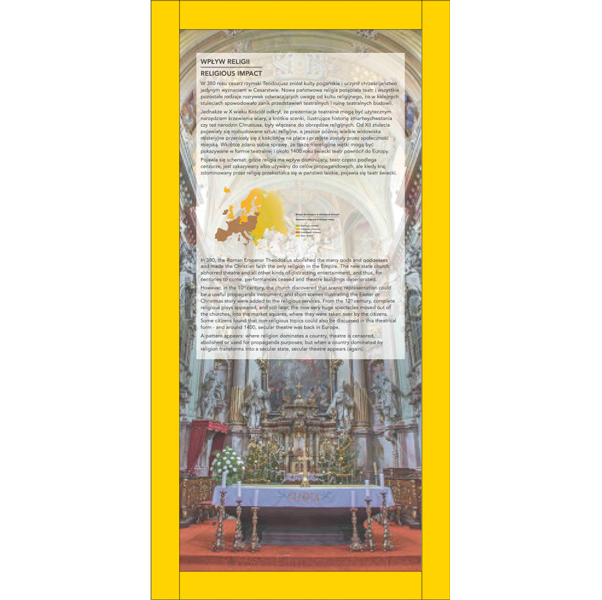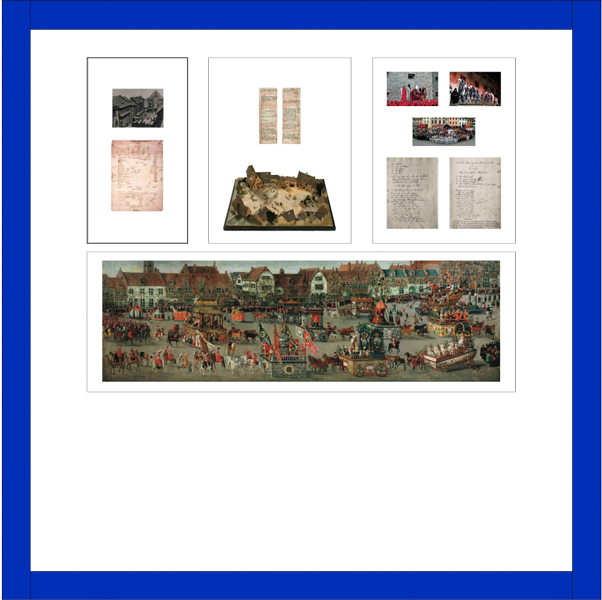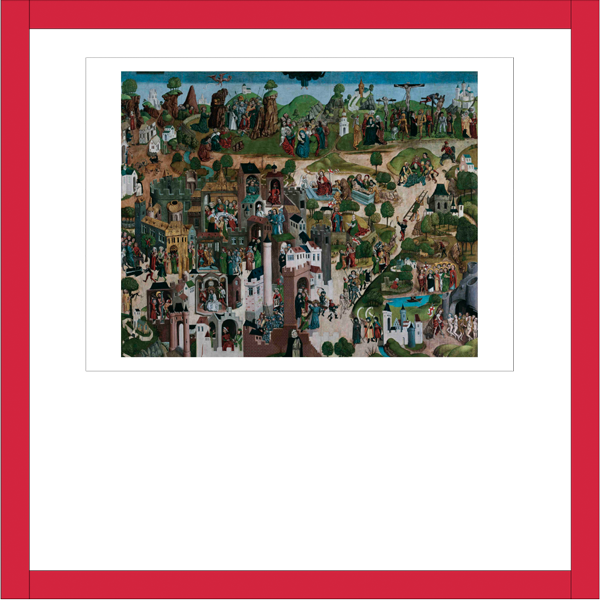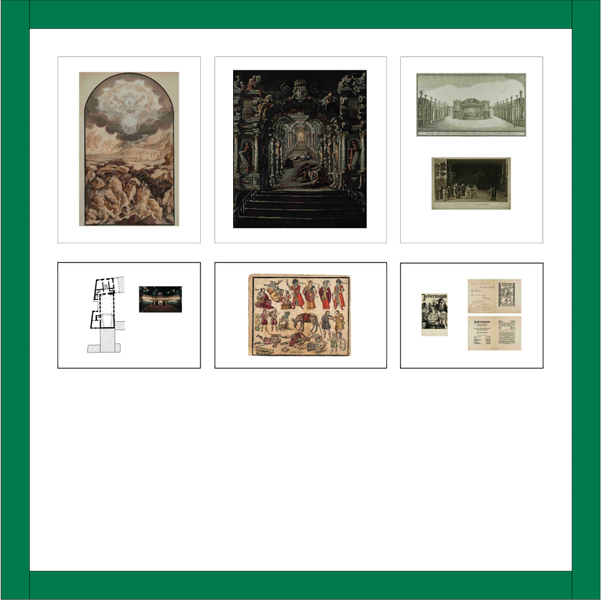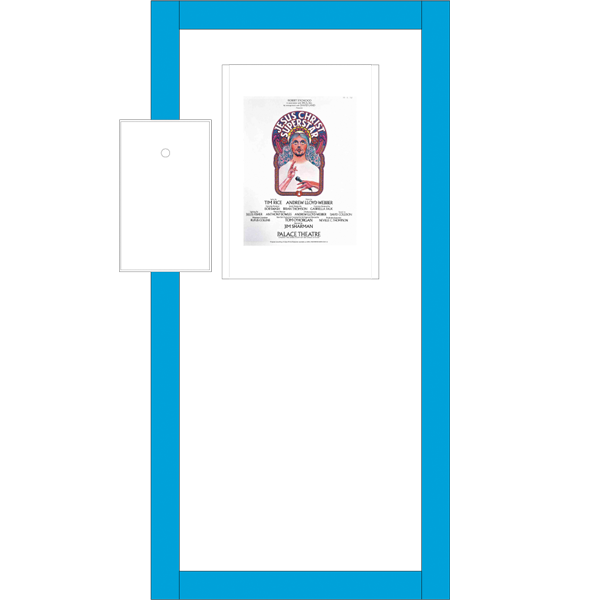Religous Impact
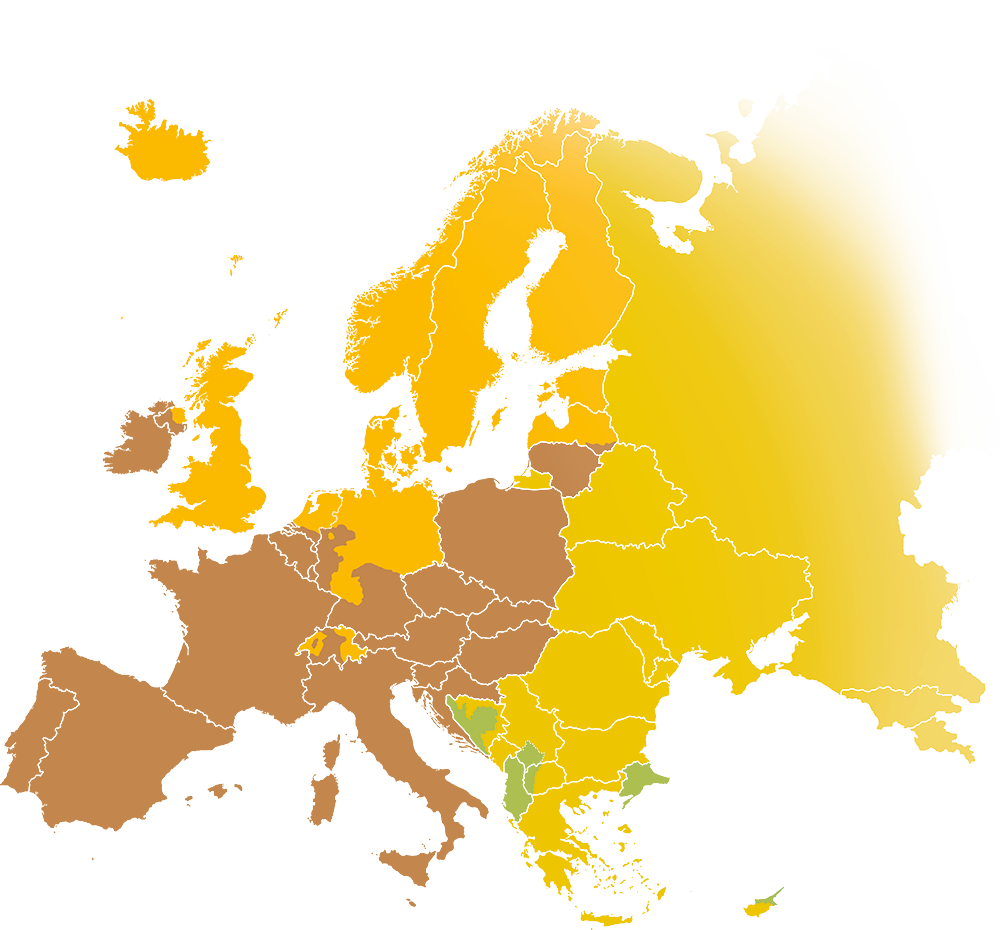
Dominant religions in Europe today
In 380, the Roman Emperor Theodosius abolished the many gods and goddesses and made the Christian faith the only religion in the Empire. The new state church abhorred theatre and all other kinds of distracting entertainment, and thus, for centuries to come, performances ceased and theatre buildings deteriorated.
However, in the 10th century, the church discovered that scenic representation could be a useful propaganda instrument, and short scenes illustrating the Easter or Christmas story were added to religious services. From the 12th century, complete religious plays appeared, and still later, the now very huge spectacles moved out of the churches, into the market squares, where they were taken over by the citizens. Some citizens found that non-religious topics could also be discussed in this theatrical form - and around 1400, secular theatre was back in Europe.
A pattern appears: where religion dominates a country, theatre is censored, abolished or used for propaganda purposes; but when a country dominated by religion transforms into a secular state, secular theatre appears again.

Albert KÖSTER (1862-1924)
Model of “Weinmarkt“ of Lucerne (before 1924)
14 x 23 x 15 cm
Photograph of postcard of a lost model in World War II
V 350, F 1197 (Hist. PK)
German Theatre Museum, Munich
This model from the historical collection of Albert Köster, theatre expert, was built after Renwart Cysat’s plan for the Easter drama in Lucerne. Since Köster’s death in 1924, it belonged to the German Theatre Museum, but was destroyed in the Second World War. Already in 1927, it had been exhibited and shown in the catalogue of the “Deutsche Theater-Ausstellung” (German Theatre Exhibition) in Magdeburg, organised by the German Theatre Museum.

Renward CYSAT (1545-1614)
Plan for the Easter drama on the Wine Market in Lucerne (1583)
55.5 x 40 cm
Indian ink
BRd.27.1.1.
Zentralbibliothek Luzern
Photo
233 A 100
German Theatre Museum, Munich
1st day: “Abtheilung dess platzes den Erste Tag” (“Partition of the square on the first day”). This is possibly the oldest theatre storyboard in the world.

N.N.
Donaueschingen Passion play (before 1500)
Two pages from the manuscript
Badische Landesbibliothek (Baden State Library), Karlsruhe
http://digital.blb-karlsruhe.de/id/588730
The Donaueschingen Passion Play is a German passion play manuscript written in the last decades of the 15th century. It took two days to perform the whole play. The first day featured several episodes from the life of Christ including the Betrayal of Judas. The second day was dedicated to the central story of the Passion of Christ starting with the Last Supper and ending with the Resurrection.
On the double page exhibited here, Jesus heals two people, witnessed by a group of malevolent Jews. In between, a group of children sings a song. A bystander calls the song mockery of the Saviour, whereupon Jesus interprets the song as praise of God.

N.N.
Donaueschingen Passion play (before 1500)
Two pages from the manuscript
Badische Landesbibliothek (Baden State Library), Karlsruhe
http://digital.blb-karlsruhe.de/id/588730
The Donaueschingen Passion Play is a German passion play manuscript written in the last decades of the 15th century. It took two days to perform the whole play. The first day featured several episodes from the life of Christ including the Betrayal of Judas. The second day was dedicated to the central story of the Passion of Christ starting with the Last Supper and ending with the Resurrection.
On the double page exhibited here, Jesus heals two people, witnessed by a group of malevolent Jews. In between, a group of children sings a song. A bystander calls the song mockery of the Saviour, whereupon Jesus interprets the song as praise of God.
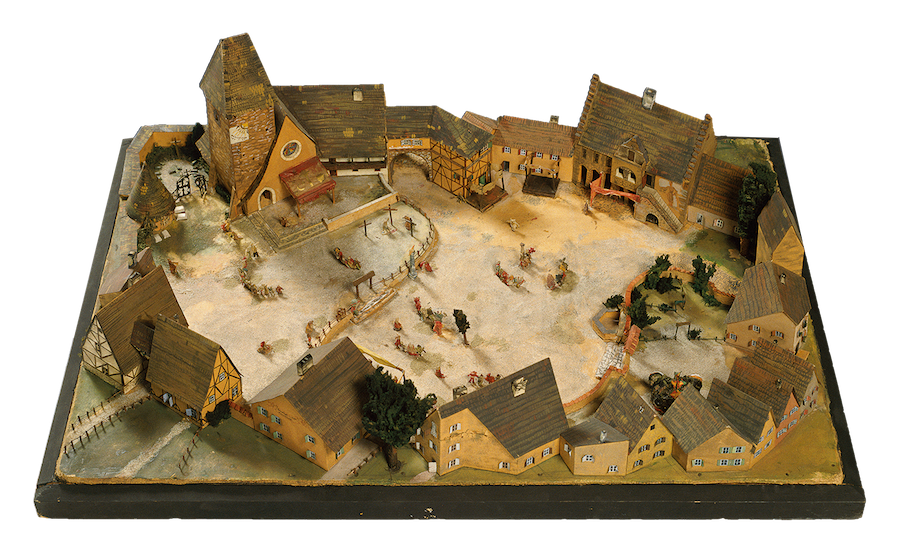
Franz von REINER (dates unknown)
Ferry WINDBERGER (1915-2008)
Model of the Donaueschingen Passion Play (1936)
43 x 112.2 x 78.9 cm
Wood, paper, various textiles and watercolour
MS_S904
Theatre Museum, Vienna
The Donaueschingen Passion Play is a German passion play manuscript written in the last decades of the 15th century. The manuscript is stored in Karlsruhe at the regional library of Baden-Württemberg. The model is an accurate reconstruction of the stage setting according to the historical sketch, which is loosely appended to the manuscript. It presents a village square with the various play stations according to the sketch: Hell, the Mount of Olives, various houses (house of Herodes, house of Pilatus, house of Kaiphas, house of the Last supper), the pillar on which the cock is sitting, the place of the Flagellation of Christ, graves including the Holy Tomb and Heaven. It took two days to perform the whole play. The first day was on several episodes from the life of Christ including the Betrayal of Judas. The second day was dedicated to the central story of the Passion of Christ starting with the Last Supper and ending with the Resurrection. This model was reconstructed for and first presented at the International Exhibition of Theatre and Dance 1936 in Vienna.

Tomaž LUNDER
The Škofja Loka Passion nowadays (2009)
2500 x 1664 pixels
Digital photo
Private collection
Once a year, on Good Friday, the members of the Capuchin order staged a Passion procession in Škofja Loka. The author was the Capuchin friar, Lovrenc Marušič. It was probably staged in 1715 and definitely in 1721, 1727, 1728 and 1734.
The “Škofja Loka Passion” was revived in 1936 and again in 1999, and staged fully in 2000, 2009, in March and April 2015. Almost seven hundred performers stage in different locations the 13 figures of the “Passion”. In 2012, the Government of the Republic of Slovenia declared it as the first living masterpiece of national importance, whilst in March 2013 the Ministry of Culture submitted a nomination for the inclusion of the “Passion” on the UNESCO Representative List of the Intangible Cultural Heritage of Humanity.

Tomaž LUNDER
The Škofja Loka Passion nowadays (2009)
2500 x 1664 pixels
Digital photo
Private collection
Once a year, on Good Friday, the members of the Capuchin order staged a Passion procession in Škofja Loka. The author was the Capuchin friar, Lovrenc Marušič. It was probably staged in 1715 and definitely in 1721, 1727, 1728 and 1734.
The “Škofja Loka Passion” was revived in 1936 and again in 1999, and staged fully in 2000, 2009, in March and April 2015. Almost seven hundred performers stage in different locations the 13 figures of the “Passion”. In 2012, the Government of the Republic of Slovenia declared it as the first living masterpiece of national importance, whilst in March 2013 the Ministry of Culture submitted a nomination for the inclusion of the “Passion” on the UNESCO Representative List of the Intangible Cultural Heritage of Humanity.

Jure NASTRAN
The Škofja Loka Passion (2009)
2500 x 1115 pixels
Digital photo
Private collection
In the medieval centre of Škofja Loka, almost seven hundred performers stage, in different locations, the 13 figures of the “Passion”, using the textbook from 1721. The performers and others involved in the Škofja Loka Passion procession unite formal and informal groups from the former Loka estate, communities and individuals from the town and the surrounding villages.
(Source: http://www.pasijon.si/en/)

Lovrenc MARUŠIČ / Father ROMUALD (1676-1748)
“Instructio pro Processione Locopolitana” (1721)
A double page from the manuscript
19.7 x 27.8 cm
Ink on paper
The Archive of the Capuchin monastery Škofja Loka
Once a year, on Good Friday, the members of the Capuchin order staged a Passion procession. The text of the Škofja Loka version by Capuchin friar Lovrenc Marušič makes use of Latin, German and Slovene. It was probably staged in 1715 and definitely in 1721, 1727, 1728 and 1734.
Scene 18 on the left page features “The company of the dead on foot. / Death, on foot, with the scythe”, as depicted in the upper right hand photo of today’s performance. Scene 19: “After these follow the others dead, big and small.” Scene 20 shows Lucifer appearing “with his devilish cavalry”.

Lovrenc MARUŠIČ / Father ROMUALD (1676-1748)
“Instructio pro Processione Locopolitana” (1721)
A double page from the manuscript
19.7 x 27.8 cm
Ink on paper
The Archive of the Capuchin monastery Škofja Loka
Once a year, on Good Friday, the members of the Capuchin order staged a Passion procession. The text of the Škofja Loka version by Capuchin friar Lovrenc Marušič makes use of Latin, German and Slovene. It was probably staged in 1715 and definitely in 1721, 1727, 1728 and 1734.
Scene 18 on the left page features “The company of the dead on foot. / Death, on foot, with the scythe”, as depicted in the upper right hand photo of today’s performance. Scene 19: “After these follow the others dead, big and small.” Scene 20 shows Lucifer appearing “with his devilish cavalry”.

Denys VAN ALSLOOT (c 1570-1626)
The Ommeganck in Brussels on 31 May 1615: The Triumph of Archduchess Isabella (1616)
117 x 381 cm
One of six paintings
depicting the Ommeganck parade in 1615 in Brussels
5928-1859
Victoria and Albert Museum, London
This painting was originally part of a six paintings series commissioned by the Archduchess Isabella, daughter of Philip II of Spain and governor of the Netherlands (1601-1633). The Ommeganck, which means ‘walk around’ in Old Dutch, is a religious and secular procession which took place every year in Brussels, and still does today. This painting reveals 17th Century street theatre as a tool for entertaining the people and demonstrating religious and secular power. It features nine processing floats with various mythological and religious scenes being enacted. The two carts in the centre feature two religious-themed scenes, an Annunciation and a living representation of the Jesse tree, with the Madonna and child at the top.

In 1583, Renwart Cysat drew this map of the market square in Lucerne, Switzerland, planning what should happen in each spot during the first day of the Passion play performance. It is the first stage sketch in European history.
The textbook of the Passion play from Donaueschingen, Germany, predates 1500. It features songs in Latin that intersperse the German dialogue (black) and stage directions (red).
During Passion plays, the audience moved from stage to stage in the market square. An alternative was moving the stages: by mounting them on chariots, drawn by horses or pushed from inside. This solution is also used in the “Ommegang” (“Walk around” in old Flemish), a tradition that started in the 14th century in the Netherlands and is still performed today. Besides chariots with biblical and mythological themes, as in the painting by Denys van Alsloot from 1615, the Ommegang also featured worldly topics.
The text of the Passion play in Škofja Loka, Slovenia, dates from 1715 and is trilingual: the stage directions are in German, some elements are in Latin, and the dialogue is in Slovenian – making it the oldest Slovenian play. Since 1999, performances have been taking place again, involving about 650 actors.

N.N.
The Torun Passion (c 1480-1490)
274 x 221 cm
Tempera on board
St. Jacobs church in Toruń
Photo © ARS-FOTO Andrzej R. Skowroński
A composition that presents the Passion and Resurrection scenes simultaneously. It was painted upon the instruction of the Dominicans for St. Nicolas Church in Toruń, non-existent today. It is a narrative outline painting. Apart from scenes from the Gospels, there are numerous genre episodes referring to daily living. All this against the background of a medieval city representing Jerusalem during the Christ's times. The painting was used in contemplative rituals and spiritual “pilgrimages” to the Holy Land, and the artist was largely inspired by the 15th century mystery plays that developed certain spatial layouts, scene sequences, mansion shapes, dresses and gestures of figures.

In Medieval churches, wall paintings and altars present the scenes of a story on adjoining panels or a number of scenes in just a single panel, so that the eye of the onlooker starts to wander from one scene to the next. An outstanding example is the Passion Altar from Toruń, Poland (ca. 1480–1490). Many details here are inspired by Passion play performances, and the movement of the eye is similar to the physical movement of the spectator or the chariots during such a performance.

Lodovico Ottavio BURNACINI (1636-1707)
Sacred representation at the Holy Tomb (c 1683)
54 x 35 cm
Pencil, watercolours, heightened with white on paper
HZ_Min29_38a
Theatre Museum, Vienna
Sepolcros are religious plays with actors representing biblical or allegorical figures. In Vienna they were performed since 1660 on Holy Friday in front of the Holy Tomb set up in the imperial court chapel. The coloured drawing by Lodovico Ottavio Burnacini was assumedly a draft for a canvas used as a decoration for these musical-theatrical representations. According to the gothic choir of the chapel it has an upright format and a rounded top. It shows the Blessed Sacrament in the upper semi-circular area. Below, Moses and Aaron are leading the people of Israel whereas their opponents are afflicted by rain fire and rushed into the burning abyss.

Johann Anton GUMPP (1682-1754)
Passion play / oratorio in the Salvator Theatre, Munich (around 1690)
55.5 x 46.8 cm, oil on canvas
IV 4412, F 3325
German Theatre Museum, Munich
On stage: interior of a church with scenes of the passion of Jesus Christ. An impressive example of the ‘Theatrum sacrum’.

Joseph POETZENHAMMER (1789-1852)
Last Supper scene of the Oberammergau Passion Play (1820)
22.5 x 38.7 cm
Lithography on paper
GS_GBU4212
Theatre Museum, Vienna
The Oberammergau Passion Play is the most popular survivor of former times passion plays, first performed in the Bavarian village of Oberammergau in 1634, and now performed every ten years. The latest production was shown in 2010, the next Oberammergau passion play will take place in 2020. The Last Supper scene on this lithography reminds the spectator of well-known standardized pictures of this episode of the Passion of Christ deriving from Leonardo da Vinici’s famous mural painting.

Joseph ALBERT (1825-1886)
Passion play of Oberammergau (1870)
11.3 x 17.1 cm
Souvenir photograph in album
II 29623
German Theatre Museum
One of the oldest stage photographs. At that time it was only possible to take photographs inside photographers’ studios because of the light. Here the open-air Passion play stage serves as a studio. Nowadays this Passion play is performed every ten years.

Ryszard MĄSZYŃSKI
Plan of Collegium Nobilium Theatre – echelon of ground level
Published in:
Ryszard Mączyński, “Pijarski Pałac Collegium Nobilium w Warszawie", 1996, Wydział I Nauk Społecznych PAN
The theatre in an annex of the Collegium Nobilium Piar Palace. A state from 1760. Reconstruction according to a project of Jakub Fontana and measuring stock-taking (1817).

Katarzyna WODARSKA-OGIDEL
Collegium Nobilium auditorium
Photo (2014)

Albrecht SCHMIDT (1667-1744)
Biblical Toy Theatre: Abraham and Isaac (c 1700)
30.3 x 38.1 cm
Hand-coloured woodcut on paper
S.87-2003
Victoria and Albert Museum, London
This sheet was printed around 1700 and later hand coloured. Several characters are featured which could be cut out of the sheet. From the series the V&A owns we can deduce that these cut-outs were meant to be used in performance in conjunction with a text, rather than as a static three dimensional image of the scene. You can see here two images of Abraham and his son Isaac in two different positions, which would have been used at different moments of the performance. Some sheets of this series about the Prodigal son, include a backdrop image which could serve as set design for the toy theatre.

Photo studio ELLINGER, Salzburg
Souvenir postcard for the production of “Jedermann” (1930)
13.2 x 8.1 cm
Photo collage as postcard
FS_PSP75421
Theatre Museum, Vienna
“Jedermann” (English: “Everyman”) is a play based on late medieval morality plays. It was modernized by Hugo von Hofmannsthal and first put on stage in 1920 by Max Reinhardt. The play uses stylistic devices, which date back to medieval times by presenting God, Death, the Devil and other abstract beings like Money or Faith as personifications with whom the title character has to deal to save his soul before he dies. The performance of “Jedermann” is until today a central piece of every year’s summer festival in Salzburg, and the roles are usually played by the most recognized actors of their time.
The photo collage referring to the performance in 1930 shows the cathedral in Salzburg with the open air stage in front of it surrounded by the most important characters respectively actors and a portrait of Max Reinhardt down left.

Hugo von HOFMANNSTHAL (1874-1929)
Playbill of the original performance of “Jedermann” (1920)
21.7 x 34 cm
Letter print and block print on paper
PA_RaraG126
Theatre Museum, Vienna
“Jedermann” (English: “Everyman”) is a play based on late medieval morality plays. It was modernized by Hugo von Hofmannsthal and first put on stage in 1920 by Max Reinhardt. The play uses stylistic devices, which date back to medieval times by presenting God, Death, the Devil and other abstract beings like Money or Faith as personifications with whom the title character has to deal to save his soul before he dies. The performance of “Jedermann” is until today a central piece of every year’s summer festival in Salzburg, and the roles are usually played by the most recognized actors of their time.
The playbill of the original performance in 1920 depicts on its cover the main character Jedermann together with the personification of Death whereas the backside bears the signatures of all actors.

Hugo von HOFMANNSTHAL (1874-1929)
Playbill of the original performance of “Jedermann” (1920)
21.7 x 34 cm
Letter print and block print on paper
PA_RaraG126
Theatre Museum, Vienna
“Jedermann” (English: “Everyman”) is a play based on late medieval morality plays. It was modernized by Hugo von Hofmannsthal and first put on stage in 1920 by Max Reinhardt. The play uses stylistic devices, which date back to medieval times by presenting God, Death, the Devil and other abstract beings like Money or Faith as personifications with whom the title character has to deal to save his soul before he dies. The performance of “Jedermann” is until today a central piece of every year’s summer festival in Salzburg, and the roles are usually played by the most recognized actors of their time.
The playbill of the original performance in 1920 depicts on its cover the main character Jedermann together with the personification of Death whereas the backside bears the signatures of all actors.

The Baroque brought performances back into the churches. A special development was the “Rappresentazione sacra al Santissimo Sepolcro” for the Viennese court: an oratorio plus minimal action, staged in the imperial court chapel in front of a backcloth that filled the apse. The sketch for such a backcloth by Lodovico Burnacini is also reminiscent of the Turkish siege of Vienna in 1683.
Theatres could be used for scenic versions of Passion oratories, as the Salvator Theatre in Munich around 1690 (oil sketch by stage designer J. A. Gumpp).
Biblical toy theatres with cut-out paper figures aimed at young people around 1700.
School theatre organized by catholic orders aimed at students – on stage – and the general public, e.g. the Collegium Nobilium of the Piarist order in Warsaw, Poland (left: plan and photo).
In difficult times, some communities made a vow to perform a Passion play at regular intervals if the town was spared. Thus originated the Passion play at Oberammergau, Germany, in 1634, still performed today (lithography 1820; photo 1871).
The secular version of this is the morality plays that appeared from the late 14th century on. A modern example is the annual “Jedermann” in Salzburg, Austria, first produced there in 1920.

ECHO PRESS
Jesus Christ Superstar (1974)
50.2 x 31.8 cm
Poster
S. 3151-1994
Victoria and Albert Museum, London
“Jesus Christ Superstar” was first performed on stage in 1971 on Broadway, and originally composed by Andrew Lloyd Weber with a script by Tim Rice as a concept recording in 1970. This poster advertises the fourth year of the show at the Palace Theatre in London. Its creation in the 1970s was inflammatory because of the alliance of religious matter and rock music, as well as the psychological and sometimes ironic approach of the characters linking the plot to contemporary sensibilities. Since then the show has been touring the world and is still showing today, popular as an example of how theatre can represent religion in the 20th and 21st Centuries.

Martin ENGELBRECHT (1684-1756)
Presentation of Jesus’ Entry into Jerusalem (c 1740)
ca. 16.5 cm x 24 cm
Hand-coloured etching on cardboard
GS_GSM3044
Theatre Museum, Vienna
Martin Engelbrecht and his brother Christian were engravers and print sellers in Augsburg, Germany during the 18th century. About 1730 Martin Engelbrecht started to create cards for miniature theatres to be inserted into a display box with a peephole. They showed religious scenes, allegories and pictures of courtly life in a 3D perspective view.

The Holy Bible and the life and teachings of Jesus are a corner stone of European culture. They are being retold in every new medium that appears – e.g. as rock musical in “Jesus Christ Superstar” (1971). Looking at the founder of the religion from such a worldly angle is possible only in the secular Europe of today. It would not have been possible at the time of the peep box, around 1740.
